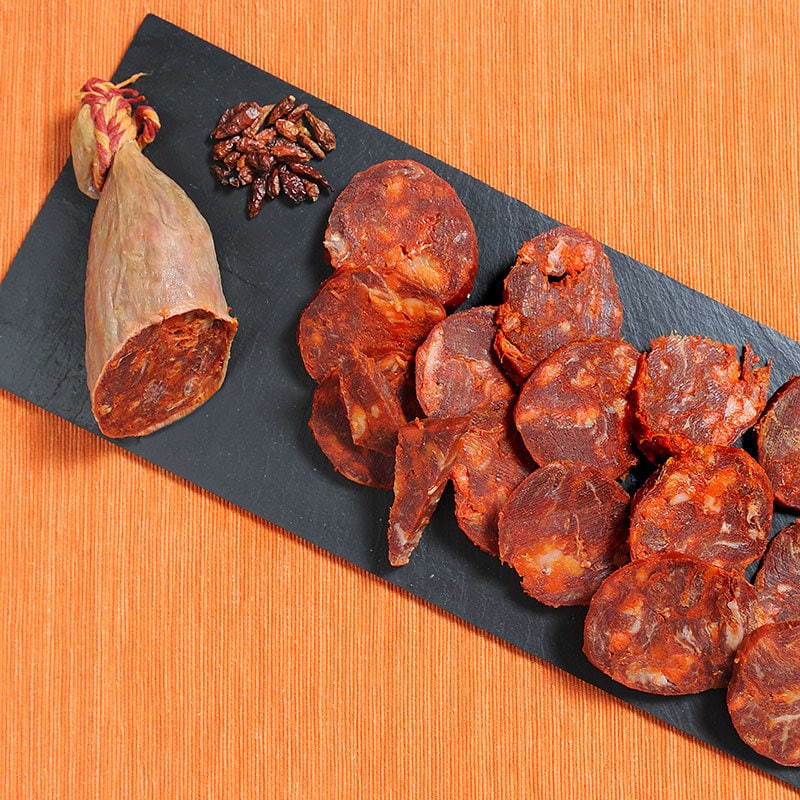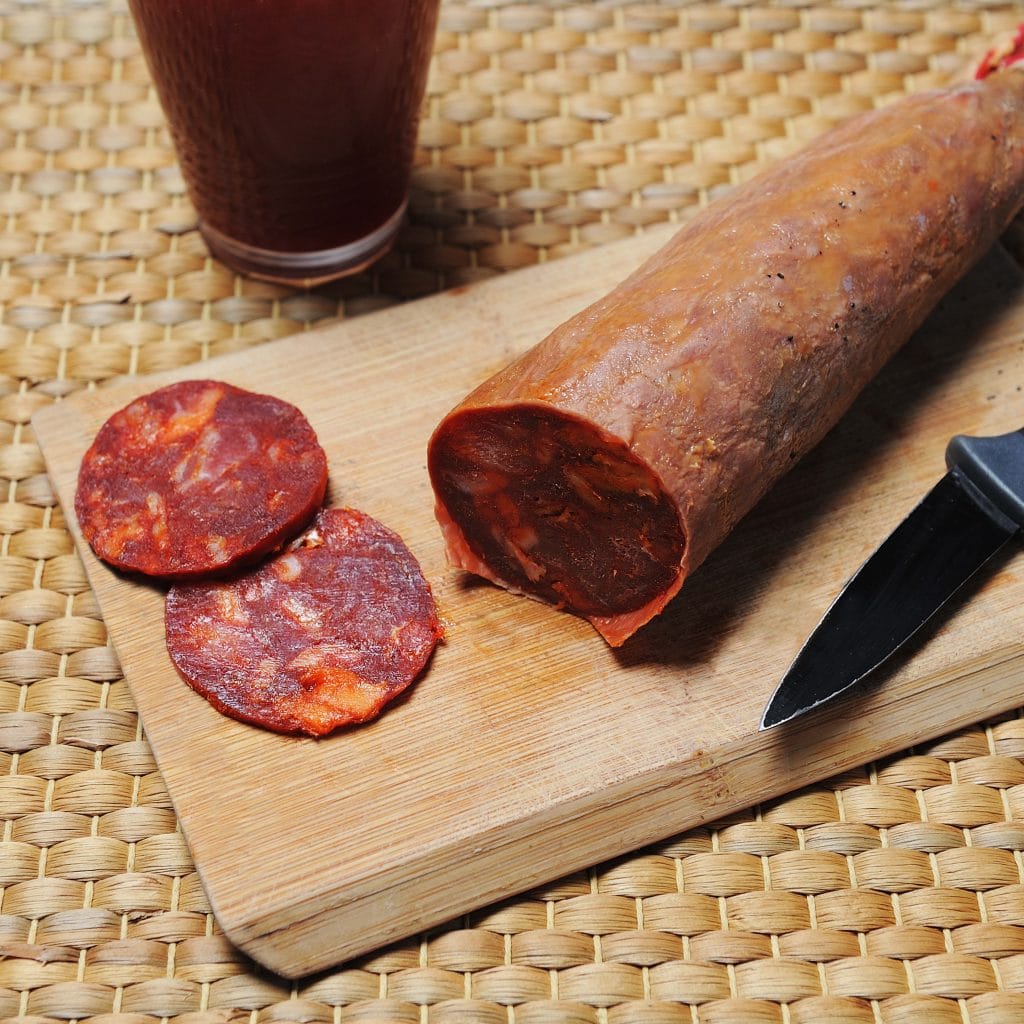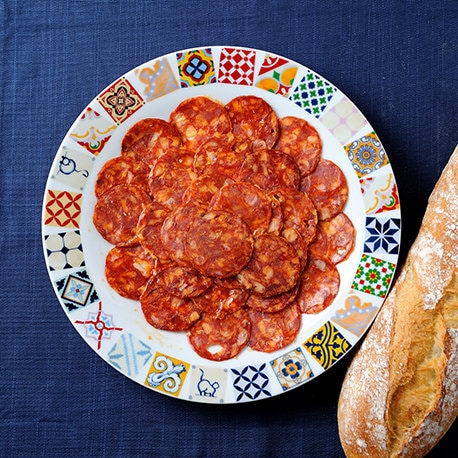If there is a Spanish sausage that stands out above the rest, this is undoubtedly the chorizo and if they give us a choice, there is no doubt that we would say the Iberian chorizo. Like the white chorizo, there are many types of Iberico chorizo. In the following lines we are going to talk and explain the characteristics of each Iberico chorizo depending on the shape, the breed and the type of curing. I hope that with these explanations, from now on, it will be easier for you to determine what chorizo you need for each occasion and that you can clearly identify the different types of Iberico chorizo that are made in the different regions of Spain.
When we can add the Iberian supplement to certain products, it seems as if a greater interest is aroused. It is not the same to say, Serrano ham than Iberian ham; Or secret what an Iberian secret, damn it, if Iberian cheese has even appeared, sincerely, I would like to know exactly what the hell is it? With the chorizo it was not going to be different and if not, I encourage you to try it. Call some friends and tell them that you invite them to eat sausage at home and then call other different friends and make the same proposal but say that the sausage is Iberian. See what happens.
In my opinion, there are three main aspects that you have to take into account when choosing an Iberico chorizo: the shape, the purity of the breed along with the diet and the curing.
The types of Iberico chorizo depending on its shape:
Depending on the type of use that you are going to give the chorizo, you can choose the chorizo between certain shapes and sizes. Some of the most common sausages are the following:
Iberico chorizo candle
The chorizo vela is a small-sized chorizo, less than 25 cm long and 3 cm thick at most. You usually find it with natural or substitute pig guts. Along with the cular Iberian chorizo, they are the most popular forms of Iberian chorizo.
Herradura Iberico chorizo
The horseshoe chorizo is a chorizo also known as chorizo string, it has a horseshoe shape and the ends are joined together by a cord. It can be up to 5 cm thick. Usually it is a homemade, artisan chorizo, which is commonly known as village chorizo.
Iberico chorizo cular
The Iberico cular chorizo is a robust chorizo, it has a thickness that can reach up to 10 cm. This chorizo stuffed into the thickest pork tripe is one of the most popular. Both the quality of the raw material used, and the care in its preparation make it an excellent chorizo. Unlike the previous chorizos. The cular chorizo is not found in white pork sausages, nor cured sausages. Of the different types of Iberian chorizo, the cular chorizo is one of the most attractive, since a very thin and wide slice is obtained, easy to take and digest.
Iberian pork chorizo according to the breed:
There are 2 aspects that will determine the quality and flavor of a chorizo, the type of Iberian chorizo according to the breed and the diet it has had and secondly the proportion between lean pork and bacon that the chorizo has.
Iberico chorizo
The Iberico chorizo is that which has been obtained from an Iberian pig of 50% Iberian breed or higher. Also known as chorizo de bait or Iberian chorizo de bait. The chorizo is obtained from pigs raised in captivity and fed on selected natural feed. There is a variant which is called Chorizo de bait de campo, chorizo de recebo or Iberian chorizo de bait de campo. It is the same Iberian pig as the previous one, with the difference that it lives in freedom.
Although the Iberian chorizo is excellent, of all the types of Iberico chorizo that we are going to see, it has the weakest quality. The other chorizo feed on grasses and acorns while the bait chorizo feed on feed. In addition, the other chorizos are obtained from pigs that live and graze in freedom, while the bait pig lives in captivity.
Acorn-fed Iberico chorizo
Acorn-fed chorizo or acorn-fed Iberico chorizo is one of the most popular. It is obtained from Iberian pigs whose breed is 75% and they have been fed on acorn and natural pastures with a free calf. The truth is that in artisan sausages, it is usually the most popular chorizo. The price difference between the bait and the acorn is not very great. Although the taste between one and the other is significant. When it comes to chorizo, it is not difficult to find cheap and good quality Iberian chorizo. Unlike loin and bacon, chorizo is a spiced sausage mixed with different meats, so its price is cheaper.
Black leg chorizo
If we hear pata negra, pay attention. There is someone who is talking about the best quality product. Although all Iberian pigs always have a black hoof, we refer to the pata negra chorizo when it has been obtained from 100% Iberian pigs. It has a unique flavor and honestly, it is the most of the most. If the quality of the raw material is good, the care and care that they put into its preparation is exquisite. There are different types of Iberian chorizo according to the breed, all of them are excellent and appropriate depending on when you are going to eat them.
Iberico chorizo according to the cure:
Curing is one of the most determining factors when choosing between the different types of Iberian chorizo, since it will determine the use that we are going to give the chorizo. If we are going to cook it, integrate it into another recipe or eat it dry. The truth is that I love any of these forms of curing, but we have to know how the chorizo is going to be used to choose the type of curing.
Iberico cured chorizo
The dry chorizo or cured chorizo is a chorizo that has lost its water and has hardened. It is considered a form of cooking. In China, the law has recently been modified to be able to import this product, since it was previously considered raw meat and could not be easily introduced into the country. The curing will depend on the thickness of the chorizo and the result to be obtained. The usual is between 1 and 3 months.
Fresh Iberico chorizo
Fresh chorizo is one that is sold as soon as it is stuffed. It is usually a sausage whose skin is transparent, since it has not had time to change color. in general, they are usually fine sausages, no more than 3 cm thick. The barbecue chorizo or the barbecue chorizo are the most common, although we can find other types such as chistorra. Without a doubt, a fried chorizo as it happens.
Iberico aired chorizo
An Iberian chorizo is considered to be a dried chorizo when it has been left to cure for a few days without the meat or its interior having hardened. The result that we are going to have is that the outside of the chorizo will be smooth and the skin of the chorizo will be somewhat dry, but the inside will be somewhat fresh. Iberian sausage is considered to be ideal for frying and making stews such as lentils with chorizo, macaroni with tomato, chorizo with cider or chickpeas with chorizo. Of the different types of chorizo according to its curing, it is very difficult to stay with just one, since each one has its use and a suitable typical Spanish dish to integrate into.
I do not want to end this article without first dedicating a few lines to the taste of chorizo. It is very important to know if you are looking for a spicy chorizo or a sweet chorizo, since it will be the conditioner of the dish, either because others do not like a certain flavor or because it does not go well with the Spanish recipe that you are going to cook. .
The Iberico chorizo, like the white chorizo, has become a somewhat unpopular food due to the calories it contains. That is a half truth, the most important thing is to have a balanced diet, eat everything and if you want to buy chorizo online make sure it is a quality chorizo, with a much higher proportion of meat than bacon. Among all the types of Iberiaco chorizo we sure have the homemade chorizo that best suits what you are looking for. Gastronomic Spain.









